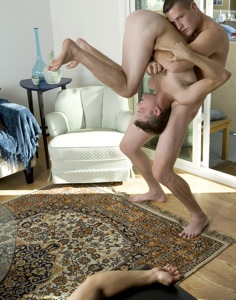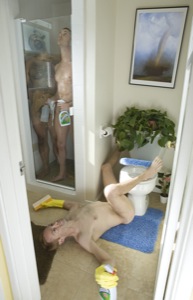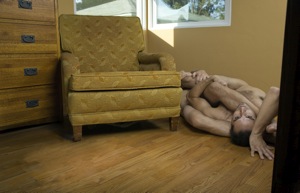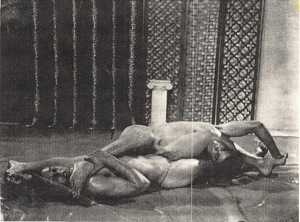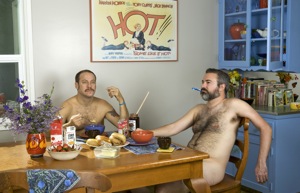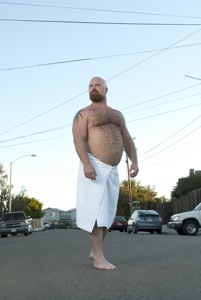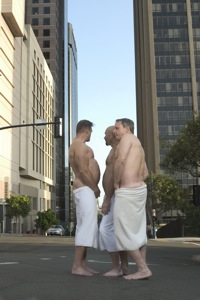-
- Wisc. couples begin registering under state’s new domestic partnership law
- Gay activists: Marriage secondary to basic rights
- Maine same-sex marriage opponents submit petitions
- Utah’s next governor mum on gay rights stances
- Scientists find HIV’s ‘missing link’ in ill chimps
- Judge halts release of Wash. referendum signatures
- National News Briefs
- World News Briefs
feature
Questioning Homonormativity
Local artist’s photographs of gay men in domestic and urban spaces shed light on issues of gay assimilation
Published Thursday, 06-Aug-2009 in issue 1128
Local photographer Andrew Printer addresses “homonormativity” – the adoption of heterosexual norms and ideals by gay people – in two upcoming photography series: “Second Thoughts from Normal Heights” and “Men in White Towels,” starting Saturday, Aug. 8, at Northpark gallery Agitprop, 2837 University Ave.
“Second Thoughts from Normal Heights” juxtaposes images of gay men with domestic contexts to show the “peculiarity” of the GLBT community’s “idiosyncratic” lifestyle in the context of heterosexual norms. “Men in White Towels” addresses the effect of gentrification on GLBT communities.
Printer sat down with Gay & Lesbian Times Staff Reporter Rick Braatz to discuss his thoughts about homonormativity, his work and his depictions of gay men.
Gay & Lesbian Times: Why are you interested in the subject of homonormativity?
Andrew Printer: This is where I have some falling outs with some of my friends. I am for civil rights. I am for equal rights. I agree that everyone should be privileged with the same set of laws. I don’t understand why marriage as an institution is so singularly the agenda. There are other people who have talked about this. My feeling is that in that little window between Stonewall and AIDS all kinds of relationships and sexual options became a potential: three people in a relationship, several people in a relationship and a certain kind of bisexuality that didn’t need to be pinned down.
Our culture, I think, has to pin things down. They have to sort of define it and fix it in heteronormative terms. I just don’t understand why a flawed institution such as marriage that doesn’t work for them, kind of started in some other place for some other reason, is what were all striving for. If it’s going to extend to this little other group, same-sex couples that duplicate, mimic with the children, with the picket fence, one going to work, one staying at home, it’s like you’re duplicating the lock, stock and barrel of a flawed institution at the [expense] of our own rough edges of our community: those people that are still marginalized, they aren’t fitting in, they’re too radical. I just have a problem with that.
GLT: What are you saying with the “Second Thoughts from Normal Heights” series?
AP: This series is basically: Here are domestic spaces. Here are classic bathrooms, kitchens, living rooms, laundry rooms. And what do we do in these places? Do we adopt the lifestyle that is exactly like straight people’s? Does our own idiosyncratic way of being, is it a different way or are we just buying exactly – like waking up, having breakfast with the kids, going to work, going shopping, going to the ball games, coming home – is that what we’re striving for, or do other things happen? So I want to make the whole proposition seem peculiar.
GLT: Why Normal Heights?
AP: Because it’s kind of a nice name. I used to live in Normal Heights. Most of them [the photos] were taken in and around North Park and Normal Heights. It’s kind of ironic that a good percentage of San Diego’s gay population lives in a neighborhood called Normal Heights and the Gay Center used to be on Normal Street. It sort of suggests that the community is marching up a hill to reach some kind of conclusion, some height, some goal, and we’re calling those heights, normal. And once you’re there, it’s kind of about rethinking the journey.
GLT: What led you to the idea for the Normal Heights series?
AP: I was doing research at a university and looked into the history of how gay people, whether they were known as gay or not, were represented in decades that had gone by in the last century. Knowing that I was going to create staged images in locations with models that I would find, I sort of looked at how this was done before by a whole range of other people. And so that was the formal strategy. And the theory was just, like, take some of these poses, these gestures, these strategies, these tactics and just lift them out, literally, which I only do in a couple [of photos] or refine them a little bit and see where it goes.
GLT: Did you take any strategies or poses from a previous work to create “Leed and Tim?
AP: “Tim and Leed” is based literally on a photo by Bob Mizer from Physique Pictorial from the mid 1950s. It’s a fake Greek studio. They use to do things like that to make it look like classical art. So that pose was in a little booklet of physic tips of how to work out. They were really used for erotic purposes. They were sent in the mail to guys who subscribed in Iowa etc. etc. So this was one of a number of photos. There may have been a series of them. So I basically said, ‘OK we’ll, I’m going to arrange this set up. This is going to recreate that.’
GLT: What are you saying with “Leed and Tim?”
AP: It’s just meant to read peculiar. It doesn’t look like they’re fighting. It doesn’t really look like they’re having sex. It doesn’t look like they’re wrestling. It looks like they’re tangled and squashed into the corner. The color pallet is obviously working. The assimilation is basically, ‘Sand off your rough edges that make you different and blend in.’ I think the whole color pallet of the image is tan: the bodies, the floor, the chair, everything. They’re just a little bit of an outside world [in the window]. They kind of disappear into the great beige melting pot of everyone and lose your defining edges. African Americans do it. Asian Americans do it. And gay people are now doing it.
GLT: What are you saying with the “Men in White Towels” series?
AP: These ones were inspired by the closure of Club 2200 [a former North Park bathhouse]. So when it closed, I noticed there was a little violent storm of letter writing in the press. The men writing the letters struck me as being older, 40, 50. And then I was like, ‘Well where are they going to go?’ Because the message around here is you have to be young, white and attractive to be represented now, and they’re for the most part not. And you got to get married and settle down and adopt a kid. And for the most part, that’s contrary to their history, and that’s unlikely that’s going to happen. So where are they going to go? Are they going to wander the neighborhoods? So I thought, ‘they are going to wander the neighborhoods with their bath towels, which is a signifier for the bathhouse. It’ll have meaning for some, not for others.
GLT: What do we have now that the place is gone?
AP: Are we a threat to this neighborhood? It’s like ‘Are they Frankenstein?’ wandering around, half looking scary, half looking vulnerable. Should we shoot them? Should we put them out of their misery? Invite them in? Are they just going to live in the streets and wonder forever?
GLT: Do you see any aspects of homonormativity in the “Men in White Towels” series?
AP: Yeah, now that that kind of business, a bathhouse, was and still does, exist around the world, now that that business, there’s a call for them to be closed, either for gentrification or the community. Some in the community, conservative people in the community, are saying ‘There’s no need for it anymore. It’s a place where diseases spread, where awful, terrible, nasty people go.’ Now that there’s a call for those kinds of businesses to close down, why is that? Is it because we want to make that property a supermarket, or an apartment building, and so we want the people who used to go there to go away or not do that anymore or to do it in the privacy of their own home? But we really don’t want to think about it. So the comment is basically, this behavior happened, those guys existed, those kinds of businesses have always existed.
GLT: And now it’s gone.
AP: And now it’s gone, but whatever went on inside those places, it still happens. It happens with straight married people. It happens with gay people. It happens behind closed doors. The assimilation and heteronormative impulses kind of deny that it happens to oppress it in some obscene way, which causes all kinds of dysfunction. So these guys are just signifiers of a behavior that happens, and where do they go now, with a bit of humor. I’m frankly not a very political person, but everything I do has a bit of humor to it.
GLT: And there definitely is humor to both of these series.
AP: It’s meant to be ‘this is kind of strange and kind of funny.’ But there is something else being said.
GLT: Can we look at “Doug, Michael and Robby” and “Scott”?
AP: “Doug, Michael and Robby” [is] just about these three figures which are locked into a configuration. It almost looks like they would be in some corner of a bathhouse. You know how you’re at a bar with all your friends, and you’re all cruising a guy?
GLT: And with “Scott”?
AP: And with this one, I don’t know if you’ve ever noticed or done this, but when you arrive at like a sex shop, bath house or a bar, and you feel really confident, and you’re just surveying and you’re, like, ‘How do I measure up to everything that I’m seeing here?’ So Scott is kind of arriving on the street. Its like, ‘Where is my place?’ in this hierarchy. But no longer is it a bar, bathhouse or a sex scene. It’s a neighborhood. And its like, ‘OK, there’s the old couple. There’s the mom and her kids.’
GLT: Where is my place in this hierarchy?
AP: Exactly, where is my place in this new hierarchy.
GLT: The subject of your photography is gay men. Why did you decide to focus on them?
AP: I often struggle with this question in terms of LGBT representation, because I don’t feel that I am in a position to speak for or represent lesbians. In some ways, gay men and lesbians have a common experience, but I don’t think our histories or issues are 100 percent the same, especially as far as representation of the naked body is concerned. Having said that, seeing as part of my philosophy is that all kinds of relationship configurations do exist in the world – gay and or straight – if I continued this series, I would have included some images involving men and women, though not women alone, because, again, I don’t believe that I have a right to speak to that experience and that history, because I’m not a woman or a lesbian.
GLT: Why did you decide to mostly use white men in both series?
AP: For “Second Thoughts From Normal Heights”, I was determined to find a variety of models. You don’t have all 12 [photos in the series] in front of you, but one photo includes three Asian, two African American and two Middle Eastern or Latin men. With “Men in White Towels” [I] admittedly only [have] one Latino man. I would have liked more variety and made a piece deliberately about race, but a reality I face is that many gay men of color – remember I use amateurs not professionals – decline to be photographed because they are on the down low or [they have] other conservative/religious family issues [by] not being out.
GLT: So what do you plan on doing next? Do you plan to continue with these themes?
AP: I just got a grant to do research at The Kinsey Institute, which is this archive at the University of Indiana, Bloomington. It was hard to gain access, but I got a grant and was able to gain access. I just spent a week there [at the institute], buried in boxes. [The Institute]... preserves the history of sexual and gender reproductive representation from 18-something right up until the 1970s. So I’m interested in archiving and how things become history and also how things are catalogued. When things get named, they get defined, they get fixed, they get categorized, and archives tend to do this. You know, there are all these institutional definitions for what the community might call something different. So yes, I plan to continue the themes. I guess I’ll get to other stuff when I’m done.
GLT: Thank you for the interview.
AP: Thank you.
|
|
Copyright © 2003-2025 Uptown Publications

